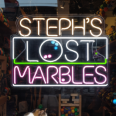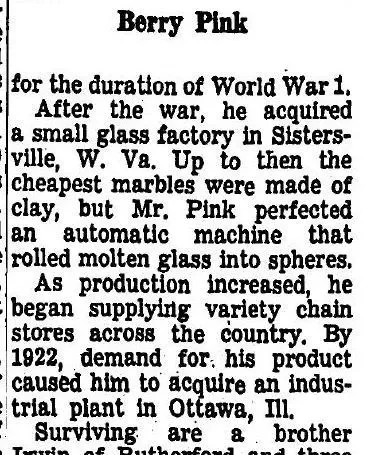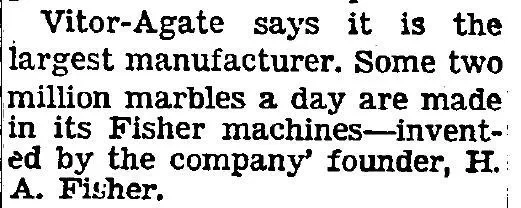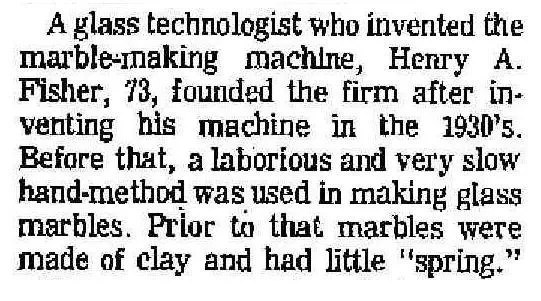-
Posts
29296 -
Joined
-
Days Won
38
Content Type
Profiles
Forums
Gallery
Events
Everything posted by Steph
-
:-) LOL. No problem. Just a glitch. I wrote the seller to tell them of our interest in the history of German machine mades and to ask for the name of the company or any information they could share. That was 3 days ago now. I haven't heard back. I wouldn't blame someone for not wanting to give out information like that. There could be many reasons to not answer, not the least of which is that I'm a stranger and they would want to protect their source for the marbles.
-
The 1970's June 1, 1974: the company closes. Feb. 25, 1975: Clinton Israel passes away after a brief illness.
-
The 1950's Ebay Slow for Some Things... - some of Don's boxes with Lion's club campaign ads.
-
1941 -- The company reorganizes Master Glass is incorporated under the sole ownership of Clinton F. Israel
-
1933 - 1934 -- the Worlds Fair in Chicago The big coup! Their famous House of Marbles: Several types of packaging, some famous, some less so: Steve's (n2marbles') bag: (click to enlarge) TO BE CONTINUED
-
Year? (if I read correctly prices are significantly higher than in the 1932 list above) (click to enlarge) . . .
-
1933 (click to enlarge) . . .
-
1932 (click pix to enlarge) . . . better detail on the Ritzy bag:
-
1931 This Master ad is from Jan 1931. I never would have guessed from the wording how early that was in the company's history. They have only been shipping for 3 or 4 months at this point but the ad is written as if they have an established track record of sales. "Preferred above all others by the marble-shooting 'stars' of boydom". Charming audacity! (click to enlarge)
-
1930 The company was founded by Akro employees Clinton Israel, Claude Grimmett and John Moulton. John Early joined them soon. It opened in May and started shipping marbles in October.
-
1951 During part of the year former Akro employees Akro is sold at auction on April 24, 1951. For part of the year former employees use the facilities to make some "general line items", but supposedly not marbles. The name under which they worked was the Clarksburg Glass Company. (AMMM, p. 10). Here is a May 8 news release pertaining to what the property may have been used for next. (click to enlarge)
-
The earliest outright "marble king" = "marble champ" reference I have is 1922. I have a very close one from 1916, which indicates the name might have been around for decades before that. I also have earlier "marble king" references for children but they're more along the lines of a pun and it's not clear what the original inspiration for the pun would have been. I would like to get my hands on the OED entry but haven't yet. Anyway, though the following are still within Pink's lifetime they are before he would have had an influence on how marbles were discussed in newspapers. in my opinion. :-) In 1920 Berry was a silk salesman. Since MFC had gone out of business, the only American company making glass marbles until something like 1925 would have been Akro. That's one of the few companies he seems never to have claimed to be responsible for. LOL. In 1930 he was an exec with the Rosenthal rubber company. When he started working for Rosenthal his options for marbles would have been severely limited. Peltier had Gropper to jobber for them. Alley didn't start making marbles until 1929 or so. So these articles are from before Pink became a force in the marble selling world. Jan. 24, 1916 April 21, 1922 May 21, 1922 Sept. 8, 1922 Have a couple more from 1923 and 1925, but still not sure about the copyright issues for 1923 and later so I am being cautious today.
-

Best ( Most Convincing ) Marble Ballast Story I've Seen
Steph replied to Steph's topic in General Marble & Glass Chat
didn't mean to equate smuggling and claiming something as ballast. just highlighting the potential for disconnect between the law and reality. And sure as heck wasn't saying Howdyshell was doing or trying to do anything improper. Again, highlighting the stakes. If you could within the law call something ballast and get out of paying taxes, then you would. If someone else was getting off too easy because he was doing that when you didn't think he should, then you'd try to change the law so he couldn't do it anymore. well, that's all my speculating for now. Maybe I'll hop over to the maritime museum in my local harbor and ask 'em what they know about how ballast was legally defined over the years. Or maybe I'll ask at the Manitowoc Shipbuilding Co. :-) -
PS to my post up there happy birthday Jess! :Party_fest33:
-

Best ( Most Convincing ) Marble Ballast Story I've Seen
Steph replied to Steph's topic in General Marble & Glass Chat
Derrick, this is the kind of thing which S-F doesn't have to put up with. This is what I referred to when I stood up for Lou for trying to do something about chronically negative voices. If you agree with Duffy then start something you consider a worthwhile thread. You dropped in to criticize. Not to be part of a solution. You reserve your best for other places. Here you criticize and stir things up. Then when things have hit fever pitch you can say how nothing has changed and this board is as contentious as ever. -

Best ( Most Convincing ) Marble Ballast Story I've Seen
Steph replied to Steph's topic in General Marble & Glass Chat
No Duffy I haven't been on many ships. I live 6 blocks from Lake Michigan in a shipbuilding town so I might be able to bluff it, but no I don't know a lot about ballast. But this thread was exactly not about the proper use of ballast. It was about people claiming things were ballast as a legal loophole. Huge difference. General ignorance could be what let 'em get away with it. How many people have been able to smuggle stuff because the laws and the officials were dense? Anyway I knew at least one other person besides myself was interested in the facts of the ballast story. It's part of marble history. I don't bust in on your threads and call 'em crap. The opposite is true. I mostly try to stay out of your threads. I posted in a couple last month but I was respectful. In private I defend the jabo posting to my friends who don't like either that or my historical trivia. LOL My vintage collector friends acknowledge that we all have a right to post but they still feel like the Jabo threads are using up all the oxygen in the room. -

How Much Is 1/5th Of A Ball Bearing Worth?
Steph replied to Steph's topic in General Marble & Glass Chat
haha. I guess I could try a patent law forum. But Brian has usually already thought out all the MFC questions before I ask 'em. Thought he might know. Or Galen or someone else who likes historical technicalities. -
six views and seller managed to avoid showing the "ends", or anyway the areas I wanted to see. lol! That pattern is unnacheral!
-

Best ( Most Convincing ) Marble Ballast Story I've Seen
Steph replied to Steph's topic in General Marble & Glass Chat
Not used as ballast. Claimed as ballast. Loophole. Reading about how Hong Kong got into the marble making business I got the strong though unconfirmed feeling that Japan was trying to launder marbles through Hong Kong to get around Britain's tariffs on non-commonwealth goods. It was awkward and one of the inducements for Hong Kong to go into the marble business themselves. Or that's the feeling I got from the portion of the article I could read about the marble industry in Hong Kong. If marbles were shipped as so-called ballast in the 1800's as claimed - not saying they were - but if they were, maybe it was to escape the high tariff on toys. I don't know the 1800's tariff(s) on toys off hand. Or what the tariffs may have been on toys from Japan before the reciprocal trade agreement. But in 1909, the tariff on toy marbles was 35%. I know that because someone tried to escape it by calling their marbles "unset precious stones". That would have gotten them through with only a 10% tax. They didn't get away with it. (article) In 1875, the tax might have been 50% on children's toys. That's what it sounded like in a case regarding glass balls for Christmas trees. The decision hinged on whether they were beads or toys. There was lots of haggling over the letter and the spirit of the customs laws. The stakes were high. I think customs tried to force Marble King to pay a toy tax on their marble bags ... maybe the cloth ones from Japan. But I believe this one Marble King won. The bag might have been fun but the ruling was that it was still packaging, not a toy. iiuc. We just heard about a modern-day case of someone hoping to semanticize themselves out of a hefty tax. Pringles in England. 0% tax on "foodstuffs" or Britain's 17.5% (now 15%) tax on "potato chips"? Well, naturally Proctor and Gamble fought for 0% and England's dept. of revenue fought for the other. P&G won last year but just lost on appeal. That's millions of dollars per year. Every million counts, right? It does sound sorta fishy that people wouldn't recognize toy marbles for what they were and charge appropriate fees in 1950 but the claim was made pretty loudly. And the general marble import situation at least was debated in Congress. The U.S. government was intent on playing nicey nice with Japan. Maybe they did let them get away with it. -

Lol ... How Many People Invented " The " Marble Machine?
Steph replied to Steph's topic in Steph's Study Hall
Here are some clips while I'm going through my files. Israel's credit from 1959: Pink's from 1962: Fisher's, from 1966 and 1970 (including 'em both just to show the story seems to have started before Fisher sold the company 🙂 -
LOL. I specially asked Carole to post pix of her puppies. :-) Thanks Carole! Chase is looking very good! I'm so happy for him. :-)






